Cross contamination is a serious challenge for food processing facilities that manufacture both allergen-free and gluten-free products and those for general consumption. Everything in the facility — from processing equipment to the air that can contain dust from food particles — must be free from contaminants to ensure the safety of these food products.
Installing a high-efficiency dust collection system is a proven engineering control to prevent airborne food particles from settling on surfaces and equipment. These highly engineered systems filter dust-borne allergens and significantly reduce the risk of cross contamination.
Dust collector considerations
Many factors go into the successful design and operation of industrial dust collection equipment. Ideally, a high-volume dust collection system is designed to capture food dust at the source using stainless steel pickup hoods at each production station. Whether you are directly hooking to batch mixers or high-velocity slot hoods behind weigh stations, these collectors pull airborne particulates into ducting and then into the dust collectors. You should place the collector in a location separate from the food production area, so that dust can be safely and effectively discarded.
Placing the dust collector in the general work area, rather than at the source, is not a good idea because dust will settle in the work area before it even reaches the collector. Such ambient collector placement also shortens filter life and decreases ventilation, greatly increasing the risk of cross contamination.
Filter specifications
Design features that are important to control cross contamination from food dust include filter orientation, filter media and filter design.
Vertically-mounted filters with a wide-pleated cartridge and a crossflow inlet deliver the best performance in maintaining the filter pressure drop in a range that allows consistent air flow to capture more allergens and other contaminants. The air used to reverse pulse clean the filters is disbursed evenly throughout the length of the filter cartridge for the most effective use of the pulse energy.
Vertical mounting also allows dust to release uniformly from the filter pleats, because it doesn’t have to fight gravity. This helps to extend filter life and reduces routine release into the air, since the filter compartment only needs to be opened when it is time to replace the filters.
Wide-pleat filters
Durable wide-pleat filters are the best solution for food processing environments, especially when a key goal is to mitigate cross contamination. You'll want to avoid dust collection cartridges that use tightly packed media configurations because much of the media surface area is unavailable for filtering. This results in dust remaining trapped within the filter, even after pulse cleaning.
A better choice is a wide-pleat filter that uses synthetic bead pleat separators to keep the pleats wide open. Because these separators prevent the media from folding over on itself, dust is effectively released from the filter cartridge and the filter doesn’t have the opportunity to plug.
This design also allows use of the entire filter media, because virtually all the media surface is exposed to the airstream. Wide-pleat filters operate at lower differential pressures, experience better dust release during pulsing, and deliver extended filter life.
Secondary HEPA/iSMF filters
If your facility is a multiproduct manufacturing operation, secondary HEPA-grade integrated safety monitoring filters (iSMF) will further ensure protection against cross contamination. The HEPA filters provide backup protection as well as a final cleaning of the air before it goes back into the facility, if you are recirculating air downstream of the collector and back into the workspace.
Filter efficiency
Primary cartridge filters are measured by gravimetric analysis, which is based on particle capture by weight. For example, filter efficiency might be stated as 99.995 percent on particles of 0.5 microns or larger by weight. The efficiency of a secondary HEPA/iSMF (which is a static loading filter) may be expressed as a Minimum Efficiency Reporting Value, or MERV, based on a scale from 1 to 16, with MERV 16 being the highest efficiency.
Food dust particles are often very small and difficult to capture and retain. Grain dusts can be as small as 5 microns, starches as small as 3 microns and milled flour down to 1 micron. Be sure that your filtration efficiencies exceed 99.99 percent at 0.5-micron particle by weight and that your secondary HEPA filters are rated up to MERV 16.
Combustible dust
In addition to reducing the risk of cross contamination from food dusts, you also must mitigate combustible dust explosions, which are a risk in many areas of a food manufacturing plant — including the dust collection system itself. Using a dust collector that is properly designed and installed for your application reduces the chance of explosion from dust buildup on floors and other surfaces. In addition, dust collectors must be equipped with proper deflagration protection — like explosion vents, flameless vents and isolation valves in the ductwork — to mitigate combustible dust incidents and comply with NFPA requirements.
In summary
Manufacturing specialty gluten-free or allergen-free food products in facilities that also process food for general consumption requires extra care. A high-efficiency dust collector with vertically mounted wide-pleat filter cartridges and a properly designed explosion protection system can significantly control airborne dust and help prevent cross contamination issues in your factory. These important measures are vital to the quality of your food products and the safety of your employees and customers.



